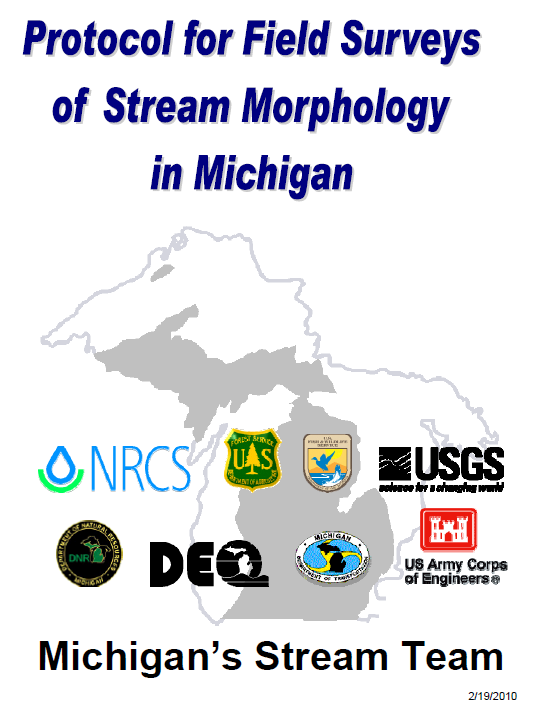The Stream Team was formed to develop a common method of taking stream morphology measurements among Michigan agencies and to assemble a database of that information in order to create regional reference curves for the entire state. For more information, see also the Stream Team presentation to DEQ management (0.5 MB).
Through the support of the respective agencies, a graduate student research assistantship was funded to coordinate the regional reference curves and conduct some of the field measurements needed to develop those curves. Many agencies also committed staff time to conducting field measurements in support of this project. The three-year project began with the 2006 field season. The results are detailed in a report titled “Estimated Bankfull Discharge for Selected Michigan Rivers and Regional Hydraulic Geometry Curves for Estimating Bankfull Characteristics in Southern Michigan Rivers”.
Regional reference curves can provide information that is critical in designing and implementing stream projects that simulate the dynamics of the natural channel including road stream crossings, bank stabilization, dam removal, habitat improvement projects. Regional curves may also be used to help understand the causes of channel instability when compared to reference reaches of similar drainage areas and hydro-physiographic regions. Using the simple regression equations and log-log plotted curves can provide an estimation of bankfull characteristics at ungaged stream locations. Only relying on the Southern Lower Michigan Ecoregion Regional Reference Curves developed through this study for stream restoration design is not recommended however. It is imperative that stream rehabilitation design incorporates information relative to the specific stream needing rehabilitation work. This would include the determination of causes of stream impairment and comparison of geomorphic characteristics of similar reference reach stream types in comparable hydro-physiographic regions. A complete and rigorous investigation is needed to ensure stream rehabilitation design success.
The document that serves as the procedural protocol to collect regional reference curve field data is the “Protocol for Field Surveys of Stream Morphology in Michigan” document. This document was completed on December 7, 2005, by the Stream Team. It is divided into two main sections: 1) reconnaissance survey and 2) full field survey. The purpose of the reconnaissance survey is to evaluate and select gage stations for the full field survey. The purpose of full field survey is to collect all the field data necessary to develop the regional curves and classify the channel using the Rosgen Stream Classification System (Rosgen 1996). The most recent version of the document is available as a Word document (1.2 MB, rev. 2/2010) or PDF document (0.6 MB, rev. 2/2010). Additional revisions to this document are likely as the regional reference curve project progresses.
In support of the regional reference curve procedural protocol, two documents were prepared by MDEQ.
-
Peak Flow Analysis of Michigan USGS Gages (2005) is available as a Word document (0.7 MB) or PDF document (0.5 MB) and fulfills step B4 of the protocol. An updated peak flow analysis (2007) includes gages with shorter records, but provides only channel-forming flow estimates.
-
Application of the Richards-Baker Flashiness Index to Gaged Michigan Rivers and Streams (5.0 MB) reports calculated flashiness values and assessed trends for USGS gages in Michigan based on methodology developed by Pete Richards and David Baker in 2004. It was intended to help the Stream Team select reference reach sites.
Additional Information:
